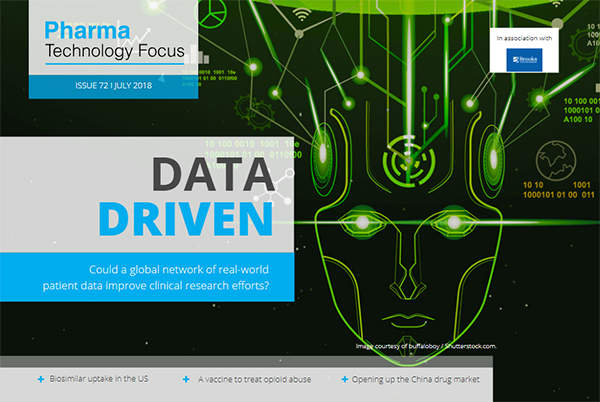
Pharma Technology Focus is now available on all devices. Read it for free here.
Despite being the world’s second biggest market for drugs function, quality healthcare in China has been hindered by red tape, lack of patient rules and underinvestment. But with wave of new changes to approval processes, is the country finally opening up?
We also take a look at the low uptake of biosimilars in the US to find out what regulatory steps need to be taken to boost adoption in the country; profile TriNetX, a global health research network that uses real-world patient data from electronic health records, tumour registries and pathology reports to improve clinical research efforts; examine a new method of manufacturing proteins outside of a cell, and take a look at a drug-based solution to America’s war with opioid addiction.
Plus, we speak to the researchers behind a new drug combination for the treatment of hepatitis C, investigate the role of AI in pharma, examine whether poor animal research studies are compromising human health and review the results of a survey on pricing strategies for gene and cell therapies.
In this issue
Opening up the Chinese drug market
The Chinese pharma market has always been inward-looking, with foreign investors deterred by an unfavourable regulatory climate. However, the government has implemented a raft of reforms with a view to ‘upgrading’ its life sciences sector. Abi Millar investigates.
Read the article here.
Boosting biosimilar uptake in the US: what needs to change?
Uptake of biosimilars in the US has been very low, especially when compared to Europe; of the nine biosimilars approved by the Food and Drug Administration, only three are on the market. What are the regulatory steps that need to be taken to improve US uptake of biosimilars? Chris Lo finds out.
Read the article here.
How well do you really know your competitors?
Access the most comprehensive Company Profiles on the market, powered by GlobalData. Save hours of research. Gain competitive edge.

Thank you!
Your download email will arrive shortly
Not ready to buy yet? Download a free sample
We are confident about the unique quality of our Company Profiles. However, we want you to make the most beneficial decision for your business, so we offer a free sample that you can download by submitting the below form
By GlobalDataTriNetX: Using real-world data to improve clinical research
Pfizer recently announced that it is joining TriNetX, a global health research network that provides anonymised, real-world patient data from electronic health records, tumour registries, pathology reports and other medical databases. Sally Turner profiles this global network and asks how the data it provides will boost clinical research efforts?
Read the article here.
Unlocking cell-free protein synthesis: biotech’s next big ticket?
A Northwestern University-led research team has invented a new method of manufacturing proteins outside of a cell, an innovation with major implications for biotech. Abi Millar speaks to the team to find out more about the potential of this cell-free protein synthesis platform.
Read the article here.
Immunising against opioids – could a vaccine solve the crisis?
A team of scientists in Minnesota are working on a vaccine against opioid abuse, stimulating the immune system to produce antibodies that prevent heroin and fentanyl from reaching the brain. So how close are we to a drug-based solution to America’s war with opioid addiction? Abi Millar finds out.
Read the article here.
Curing hepatitis C at a fraction of the cost
A new hepatitis C combination therapy has a 97% cure rate for patients and can be produced at a fraction of the cost of current treatments. Sally Turner finds out more about its potential impact.
Read the article here.
Why artificial intelligence and pharmaceuticals are a perfect match
Whether you subscribe to the notion that AI is here to benefit or destroy humanity, it’s hard to argue that there are some things that AI does better than humans. One of these things is digest huge swathes of information and connect dots in a way that humans will never be capable of. Daniel Davies looks at how BenevolentAI has plans to use this talent to change the way we discover new drugs.
Read the article here.
Shaky foundations: The flaws in animal research reporting
A new systematic analysis has reiterated concerns over the quality of reporting for preclinical efficacy data from animal studies. With these findings in mind, what are the flaws in animal research reporting, and why aren’t regulators and industry sponsors kicking up more of a fuss about it? Chris Lo investigates.
Read the article here.
Paying the bill for innovative gene and cell therapies
As new cell and gene therapies hit the market, their life-saving potential is clear – but who pays for them is less obvious. A recent survey of pharma experts revealed divided opinions on the subject. Abi Miller explores why today’s pricing and reimbursement models will not suffice in tomorrow’s market.
Read the article here.
Next issue preview
Genentech has signed a $1bn open-ended drug discovery collaboration with Lodo Therapeutics to discover unique, natural products from the microbial DNA found in soil. With this level of investment confidence must be high, but just how much potential lies in soil, and how can it be harnessed?
We also explore whether a cannabinoids breakthrough signals hope for epilepsy treatment, find out about an innovative approach to cancer research and clinical trials from the University of Texas MD Anderson Cancer Center, and following the launch of a programme to add novel treatments to Novartis’ malaria pipeline we take a look at the need for new antimalarials.
Finally, we examine the latest requirements for freight hubs that prepare pharma products for transport by air and following the FDA’s decision to publicly list the names of pharma companies that may have been denying access to reference samples for generic drug manufacturers, we ask if this ‘name and shame’ approach is justified.






Related Company Profiles
Genentech USA Inc
Lodo Therapeutics Corp
TriNetX LLC
BenevolentAI Ltd